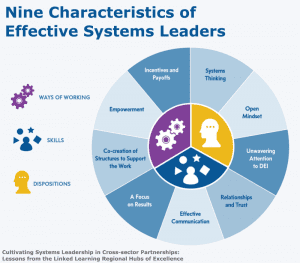Over the course of our engagements examining the successful components of place-based systems change investments, Equal Measure and our partners have distilled many highly useful findings for our clients. For the next few months, we’ll be sharing short, bite-size, and easily digestible elements of these lessons learned through an ongoing series we’re calling Tools & Frameworks.
Investments in the social sector have become increasingly complex, with many foundations shifting toward strategies focused on improving outcomes for entire populations and communities. These systemic change efforts require coordination among stakeholders across all levels of the practice and policy continuum—from direct service providers, to nonprofit intermediaries, funders, advocacy organizations, and policymakers. We asked: what does it take to be an effective systems leader in this complicated constellation of partners?
Think systemically
Effective systems thinkers step back to see the big picture—going beyond the day-to-day needs of a project to take into account the complex tapestry of the relevant history of an issue, investment, or community, the disparate and sometimes conflicting goals of local partners, and the changing economic, political, and cultural conditions on the ground. From this vantage point leaders can detect patterns and relationships to leverage or disrupt as a means to realizing positive change. Related to adaptive leadership, the value of systemic thinking skills rests on the notion that to be influential, leaders must have nuanced awareness of what is happening in the system, and that this will enable them to learn, innovate, and test solutions.
 Have an open mindset
Have an open mindset
Systems change work is by nature risky and developmental. To succeed, systems change leaders therefore must embrace learning, ambiguity, uncertainty, and experimentation. Systems change leaders demonstrate the audacity to disrupt the status quo for the sake of making programs and services more effective and true to their purpose, and are flexible enough to amend initial strategies when unexpected paths and opportunities emerge.
Press for unwavering attention to diversity, equity, and inclusion
Effective systems leaders apply a diversity, equity, and inclusion lens to their work, and must be adept at creating constructive discomfort and tension around inequity. They must also communicate authentic passion for and commitment to social justice, in order to galvanize action, continuously drawing attention to the inequities embedded in the systems they seek to change.
Build relationships and trust
Relationships and trust are the foundation for growth and change. Systems leaders who are in it for the long haul have patience for developing trust, and invest the time it takes to see progress toward shared goals. Empathy is critical for building relationships and trust—actively sensing others’ emotions, understanding their perspectives, and taking an active interest in their concerns.
Practice effective communication
Systems leaders listen deeply to points of view that may be different from their own, and are able to craft narratives that resonate for a broad range of stakeholders in order to inspire collaboration and change. They are skilled at identifying and illustrating where common interests lie and can facilitate conversations that explore disparate points of view among various stakeholders. Because systems change work often needs to break down silos between different sectors to solve a problem together, familiarity with the professional languages of multiple sectors can do much to create the necessary levels of trust.
Focus on results
At the outset of a project, and in collaboration with partners and stakeholders, systems leaders should set up a process where the stakeholders or their representatives agree on what success looks like, and on milestones that will signify “early wins.”
Organizing collaborative activities around clearly articulated desired results that reflect shared values is one way to ensure various moving parts of a collective coalesce toward common aspirations, rather than toward disjointed programmatic or sector goals, and helps to break down organizational silos.
Co-create support structures
Systems change requires partners to work together in new ways. Co-creating joint processes can enable deeper idea exchange among representatives of all organizations and communities touched by the change process—including those directly affected by the initiative. Data-sharing agreements, group-decision-making, codifying partners’ commitments, and nimble governance structures are among other aspects of effective support infrastructure.
Empower the collective, rather than the individual
Inspirational leadership has value, but on its own it lacks capacity to solve enduring systemic issues. Effective systems leaders recognize that there are actors at multiple levels that need to lead change in their respective contexts. When leadership and power are distributed, single leaders’ roles diminish and buy-in from multiple stakeholders is expanded, decision-making bottlenecks are reduced, and the likelihood increases that the change wrought by the project will have long-term staying power. Sharing power and abandoning “I” thinking for “we” thinking is a necessary stance for effective systems leadership.
Create opportunities for individuals to see the benefits of their participation
Effective systems leaders help partners understand and articulate the benefits of participation, enabling them to discover innovative strategies that stretch their resources further to accomplish more. Systems change takes time, and systems leaders will be called upon to help partners identify evidence of interim progress and put the progress in a context that benefits the partners’ individual and organizational goals, continuously reminding stakeholders of the value of the collaborative work and keeping them engaged and encouraged. Doing so can go a long way to sustaining the momentum of the systems change effort.
Special thanks to the James Irvine Foundation, Jobs for the Future, and Harder + Co for their partnership in developing this framework. To learn more about cultivating systems leadership, read our full brief.